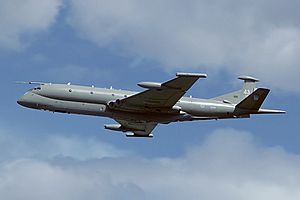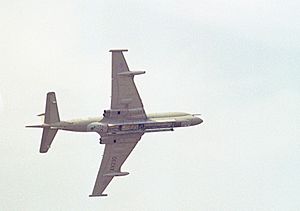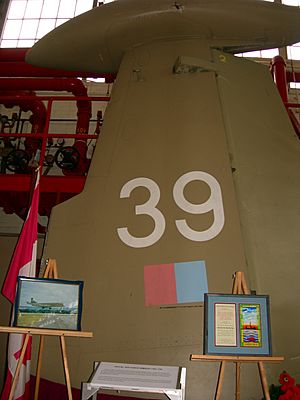1995 Royal Air Force Nimrod MR2 crash facts for kids

Nimrod MR.2, identical to the aircraft lost
|
|
| Accident | |
|---|---|
| Date | 2 September 1995 |
| Summary | Pilot error |
| Site | Lake Ontario, 0.8 km from Toronto |
| Aircraft type | Nimrod MR2 |
| Operator | Royal Air Force |
| Registration | XV239 |
| Crew | 7 |
| Fatalities | 7 |
| Survivors | 0 |
On September 2, 1995, a Royal Air Force (RAF) Hawker Siddeley Nimrod plane had a terrible accident. It crashed into Lake Ontario in Canada during an air display. All seven people on board sadly died. This was the second time an RAF Nimrod was lost in a few months.
Contents
What Was the Nimrod Plane?
The aircraft involved in the crash was named XV239. It was a Nimrod MR.2 plane. This type of plane is a maritime patrol aircraft. This means it is designed to fly over the sea. It helps to find submarines and ships. The plane was part of No. 120 Squadron from RAF Kinloss.
The Nimrod XV239 was first delivered to the RAF in 1971. It was an MR.1 model then. Later, in the mid-1970s, it was one of 35 Nimrod planes chosen for an upgrade. It became an MR.2, which was a newer and better version.
Why Was the Plane in Canada?
On August 23, 1995, the Nimrod XV239 and its crew left RAF Kinloss. They were flying to Canada. The plan was for the plane to take part in two different air shows. First, on August 26 and 27, the plane was shown at the Shearwater International Air Show. This show was in Nova Scotia.
After that, the plane flew to Toronto Pearson International Airport. This airport would be its base. From there, it would perform at the Canadian International Air Show (CIAS). The flight moves planned for the show were not new. They had been used to display the Nimrod for about 20 years. The four-and-a-half-minute routine was thought to be "relatively straightforward."
The day before the CIAS display, the plane's captain, Flight Lieutenant Dom Gilbert, gave an interview. He said that the plan was to push the plane's performance to its limits.
How Did the Crash Happen?
On September 2, the plane left Pearson Airport on time. The weather was very good. There was a slight wind coming from the lake. The air show was happening over Lake Ontario. The crew completed their safety checks. Then, the plane began its standard display sequence. This included two trips around the display line. The display line is where the crowd watches. It also included two "dumb-bell" turns.
What is a Dumb-Bell Turn?
A dumb-bell turn involves turning away from the crowd. The plane climbs to about 1,000 feet. Then, it turns in the opposite direction. Finally, it flies back down towards the display line.
The Final Moments of the Flight
The Nimrod successfully completed the first circuits and the first dumb-bell turn. After that, it did a slow fly-past. During this, its undercarriage (landing wheels) were lowered. Then, the plane turned to the right. It was starting its second dumb-bell turn. The undercarriage was raised. The flaps were set to help the plane climb. It climbed at a steep angle of 24 degrees.
As the plane reached the top of its climb, its airspeed dropped to 122 knots. This happened because the engines were powered back. Then, the plane banked (tilted) and pointed downwards. The airspeed increased a little, but it was still too slow. The recommended speed for that part of the display was 150 knots. Also, the g-force on the plane went up to 1.6g.
The low speed and high g-force caused the plane to stall. When a plane stalls, it loses lift. The plane's nose dropped 18 degrees below the horizon. It also tilted 85 degrees to the left. The crew tried to fix it. They applied full right aileron and full engine power. But the plane was too low to recover. It hit the water. The impact caused the plane to break into pieces. All seven crew members died instantly.
Finding the Wreckage and Crew
The recovery effort started right away. Divers first found the wreckage. It had broken into four main parts. But they could not find the crew members. To help with the search, a boat from the Toronto Police Service arrived. It had a remotely operated underwater vehicle (ROV). This ROV had sonar and video cameras. It showed clear pictures of the wreckage. This helped the recovery team. They were able to find the bodies of the crew and parts of the plane.
What Did the Investigation Find?
There was a lot of information available about the accident. This was because it happened in public. The RAF inquiry looked into everything. They found that all of the plane's systems were working normally. This meant that the crash was not caused by a problem with the plane itself.
So, the inquiry focused on what the crew did. They looked closely at the actions of the plane's captain. They found that at an earlier air show, the captain had made a mistake. After a dumb-bell turn, he had flown over the display line. This should have been reported. If it had been reported, his display moves could have been checked. This would have happened before a practice run.
Instead, when he went to Canada, the captain changed the move. He made his turn tighter. He did this to avoid flying over the crowd. He tried to do this by reducing engine power. This change removed the safety limits for the plane. It made the plane fly below the recommended speed. This led to the plane stalling.
The inquiry also found problems with the training for Nimrod display pilots. There was no clear training program. It lacked theory, simulations, and practice flights. Also, there was not enough supervision during flights. These issues may have caused the captain to try moves that were outside the plane's safe limits.
Changes After the Accident
After the RAF inquiry, changes were made to how Nimrod display crews were chosen. Before, several Nimrod captains and crews were picked each year. After the inquiry, this changed. Now, only one crew is chosen. This crew is made up of instructors. They are specially selected from the Nimrod Operational Conversion Unit. They are not chosen from regular squadrons.
See also
- 1995 Royal Air Force Nimrod R1 ditching
- 2006 Royal Air Force Nimrod crash



